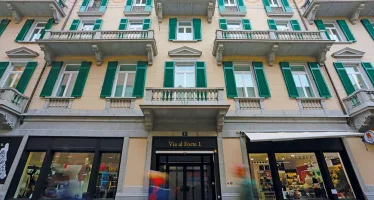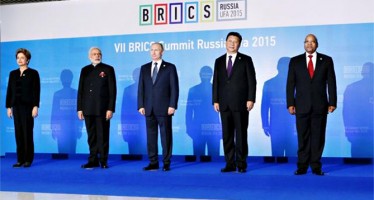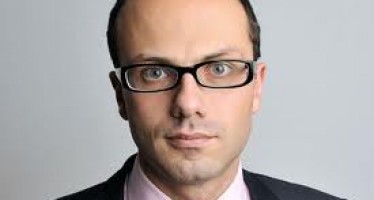Werner Hoyer, President of the European Investment Bank (EIB): A Mostly Unseen Hand
In late-December, President Werner Hoyer of the European Investment Bank shared his experiences and insights with CFI.co.

President: Werner Hoyer
He leads an institution more than twice as large as the World Bank, yet remains virtually unknown outside financial circles. Werner Hoyer (66) started his second six-year term as president of the European Investment Bank Group, comprising the European Investment Bank (EIB) and the European Investment Fund, on the first of January. A powerful financial tool for implementing EU policy initiatives as formulated by the European Council, the EIB is the only bank owned by the EU member states and, as such, represents the long-term interests of the European Union. During his first tenure, Mr Hoyer managed to increase the Group´s annual financing volume from €55bn in 2012 to €84bn last year with a corresponding jump in supported investments to €287bn.
A significant part of that growth stems from the European Commission’s Investment Plan for Europe (IPE) – colloquially known as the Juncker Plan – which so far saw the EIB Group approve €51bn in co-financing for investments totalling €256bn. The Juncker Plan’s stated aim – “to get Europe back to work” – is largely on track to be achieved in the three-year period envisioned at the time of its unveiling in November 2014.
The job, however, is not yet done. It never quite is. The bank now stands ready to, amongst other initiatives, offer substantial support to countries most likely to be seriously affected by the UK’s impending exit from the union – such as Ireland.
In September, the EIB launched a €300m midcap lending programme specifically directed at Irish companies, thereby offering direct support to businesses. In 2017, the EIB provided around €1bn worth of financing in Ireland – a record volume for the country. The new programme aims to close the funding gap that existed for mid-sized companies seeking between €7.5m to €50m in investments. Up to now, the EIB provided direct financing to large corporations and channelled funds earmarked for SMEs via privately-owned banks, leaving midcaps largely out of the picture.
“Whilst our growth has been tremendous, it is not the prime metric that motivates us as a bank.”
“Whilst our growth has been tremendous, it is not the prime metric that motivates us as a bank,” says Werner Hoyer: “Our mandate calls for the bank to support EU policy and help foster the cohesion of the internal market. The bank’s professionals are as competitive and experienced as their peers at commercial banks but operate on a slightly different premise which does not necessarily include ever-growing balance sheets.”
Mr Hoyer, a native from Wuppertal, Germany, explains that the EIB’s priorities mirror those of the European Council and include climate change action, improving SME access to financing, and encouraging technological innovation, amongst others: “These are key areas that supplement the bank’s historic mission to help finance infrastructure development – the basis of the bank when it was set up sixty years ago.”
Stepping Up to the Plate
The EIB came into its own as the 2008/9 financial crisis crossed the Atlantic to strike Europe. “During the first phase of the crisis, the EIB’s job was to protect European companies and ensure their continued access to finance. The bank rallied to the cause and leveraged its own capital towards that end. However, by the time I arrived, towards the end of 2011, the balance sheet had reached its limit.”
“In order to implement the second phase of the response to the crisis – the one that called for growth and job creation – the EIB needed, and was granted, a capital injection which allowed the bank to act in a counter-cyclical manner and become a driver of growth. In a unique move, the member states for the first time ever approved a €10bn pay-in increase in the bank’s capital. It was a truly amazing and significant moment. Since its founding in 1958, EU member states had contributed just €14bn in actual cash towards the EIB’s capital.”
The EIB’s own funds, currently just shy of €70bn, represent around 12% of the bank’s approximately €580bn balance sheet total. As multilaterals go, EIB numbers are unusually big. Annually, the bank places anywhere from €60bn to €90bn in bonds on the world’s capital markets. “At any given time, there is about €500bn in EIB bonds floating around. This level of borrowing requires us to maintain a highly competitive and rigorous orientation in order to keep the trust of investors.”
In effect, the EIB benefits, albeit perhaps indirectly, from the European Central Bank’s hawkish approach to crisis management and solution as defined by its president’s now (in)famous 2012 intervention. Mario Draghi’s unequivocal assurance that the ECB will do “whatever it takes” to save the euro, fundamentally changed the course of events. Those three words almost instantly calmed jittery markets and provided a solid backbone for the European Union’s determination to tackle the crisis. The EIB has never drawn upon its credit lines with the ECB but the mere fact that they exist and are vast is enough to make the bank into the proverbial 800-pound gorilla ready to deal with any, and all challenges.
In a show of its force, the EIB set out to leverage its €10bn capital injection to generate, within three years, €180bn or so of investments. “We managed to reach that goal nine months early, which constituted a major success”, says Mr Hoyer. The remarkable achievement did not remain unnoticed in Brussels. It also piqued the interest of Jean-Claude Juncker who, at the time, was preparing his – ultimately successful – bid for the presidency of the European Commission. Mr Juncker turned to the EIB for inspiration and asked Mr Hoyer to help him devise a comprehensive plan to kick-start the then mostly flat-lining European economy.

New Reality
“By 2014, the situation had changed for the better. There was ample liquidity and interest rates were near zero. Moreover, there was no shortage of good, solid, and much-needed projects that required financing. However, all that liquidity was not flowing into these projects, perhaps because of reluctant investors, a malfunctioning of markets, or a more generalised aversion to risk. Mr Juncker then took the very courageous decision, together with Budget and Human Resources Commissioner Kristalina Georgieva [now CEO of the Word Bank], to convince the European Parliament to take €16bn out of the EU budget, money earmarked for subsidies and grants, and put those funds in a guarantee facility [European Fund for Strategic Investments – EFSI] with a €5bn top-up in EIB cash, for a grand total of €21bn. To this sum, we can then add a multiplier effect of fifteen for a €315bn impact on the European economy. So that was, in a nutshell, the big adventure we entered into a few years ago.”
The Juncker Plan delivered on its promise. With around 80% of the funds committed, a preliminary impact analysis has found that the plan added at least 0.7% to the union’s collective GDP and – even more importantly – created over 690,000 jobs. The plan also unlocked credit to around 540,000 SMEs. “Impressive though these numbers are, this is just the short-term effect of the Juncker Plan. Over the longer-term the question becomes what the initiative means for Europe’s productivity levels, its competitiveness, and its position in the world. It would be fair to conclude that the plan’s impact is cumulative and will produce much higher figures over the next ten years or so.”
Mr Hoyer attaches significance to the Juncker Plan’s medium to long-term effects. He notes that, during the financial crisis Europe turned inward in order to put its house in order: “Meanwhile our main competitors in Asia and North America moved forwards in terms of competitiveness. We must catch up now that the need of counter-cyclical action and intervention has diminished. Economies are back on track, growth has returned, and jobs are being created: we can now concentrate our efforts on addressing the structural weaknesses of European industry.”
In this, Mr Hoyer cautions against competing on labour cost. He proposes to invest in technology, research, innovation, and education instead: “The education of the future workforce is the key to growth, yet is often ignored. Just a few member states manage to meet he education and research targets set by the European Council. We have to boost our competitiveness by investing in education and research.”
Philosophical Shift
The largest of the three pillars sustaining the Juncker Plan – the European Fund for Strategic Investments – represents a shift in philosophy as it moves private investments into higher-risk projects previously underwritten by public funds. “As such, it represents a much more effective way of allocating the EU’s resources. It also does away with the subsidies-and-grants mentality and ensures a higher impact of EU policy initiatives.”
Mr Hoyer makes no excuses as he bluntly concludes that the EU has not yet fully developed its tremendous potential. “It has done a particularly poor job in telling the true European story as it relates to politics, business, culture, and other fields. However, my own convictions have not suffered as a result and I fully believe that after the horror year of 2016, with Brexit and the uncertainty in the US, Europe will bounce back. In fact, that bounce is already happening right now, attesting to the resilience of our common project.”
Brexit
Twice minister of state at the German Foreign Office – in the fifth cabinet of Chancellor Helmet Kohl (1994-1998) and in the second cabinet of Chancellor Angela Merkel (2009-2012), Werner Hoyer was intimately involved with the drafting and redrafting of European treaties and the complex negotiations resulting from those efforts. Mr Hoyer enjoys a reputation as an ardent advocate of the European project and is not usually lost for words when addressing its detractors or critics. In 2011, still at the Foreign Office and in charge of German-French relations, he chastised Denmark for mulling the reintroduction of border controls in words not normally heard from a top diplomat.
The UK’s decision to exit the European Union is not one Mr Hoyer cheers: “It is not only a terrible mistake, but hurts the British people and all member states of the European Union as well. It is a sad thing and a defeat for us all. Unfortunately, the hit will be felt hardest by the British people themselves. However, it also affects the EIB. Remember that member states have only paid in just above €20bn. That modest sum has a huge multiplier effect as previously described. Now, you take out part of that paid-in capital and the leverage works in reverse. The UK owns 16% of the bank’s shares and we must now see how we can mitigate this loss. We are, however, quite optimistic as the remaining member states are fully behind the bank. In fact, the president of the European Council, Donald Tusk stated at the end of the last summit that ‘the EU is committed to preserving the financing activity of the EIB Group and its business model throughout and after Brexit’.”
The Unknown Behemoth
The European Investment Bank is the world’s largest multilateral lender – by far – with 2.5 times the financial firepower of the much better-known World Bank. It is not a bank that conducts its business with fanfare. Its mostly unseen hand helped reshape European markets and create new ones such as those for project finance and green bonds. In 2007, the EIB introduced the world’s first-ever climate-aligned bond, effectively creating a new asset class that has now ballooned into a €600bn global market. In 2015, the bank put in a repeat performance with Tera Neva, a climate-awareness bond that allows investors to align their financial and energy transition goals. The bond is linked to the Ethical Europe Climate Care Equity Index and has already received €500m from institutional investors.
An innovator par excellence, albeit more of a silent partner than a rambunctious one, the EIB’s own trajectory closely matches the ascendancy of the European Union from a group of six founding members in the late 1950s to a collective spanning the continent. The bank has outgrown its original mission to provide infrastructure funding and is now situated at the cutting edge of EU policy, successfully deploying its financial might to implement the shared vision of the union’s member states. It is, as such, the largest multilateral bank many Europeans have never heard of.
You may have an interest in also reading…
Care, Fairness, Trust, and Respect Allow Copernicus to Look Beyond
Deep financial expertise and a holistic approach to business drive Swiss firm’s expansion Independent financial group Copernicus is true to
BRIC-à-Brac: Requiem for a Wishful Thought
In the end, it may have been nothing more than a flash in the pan. Unable to fulfil the promise
G8: Could the Solution to Growth be Simpler Taxes?
There has been much talk of the need for growth at the G8 meeting. Could it be that the solution


















































































